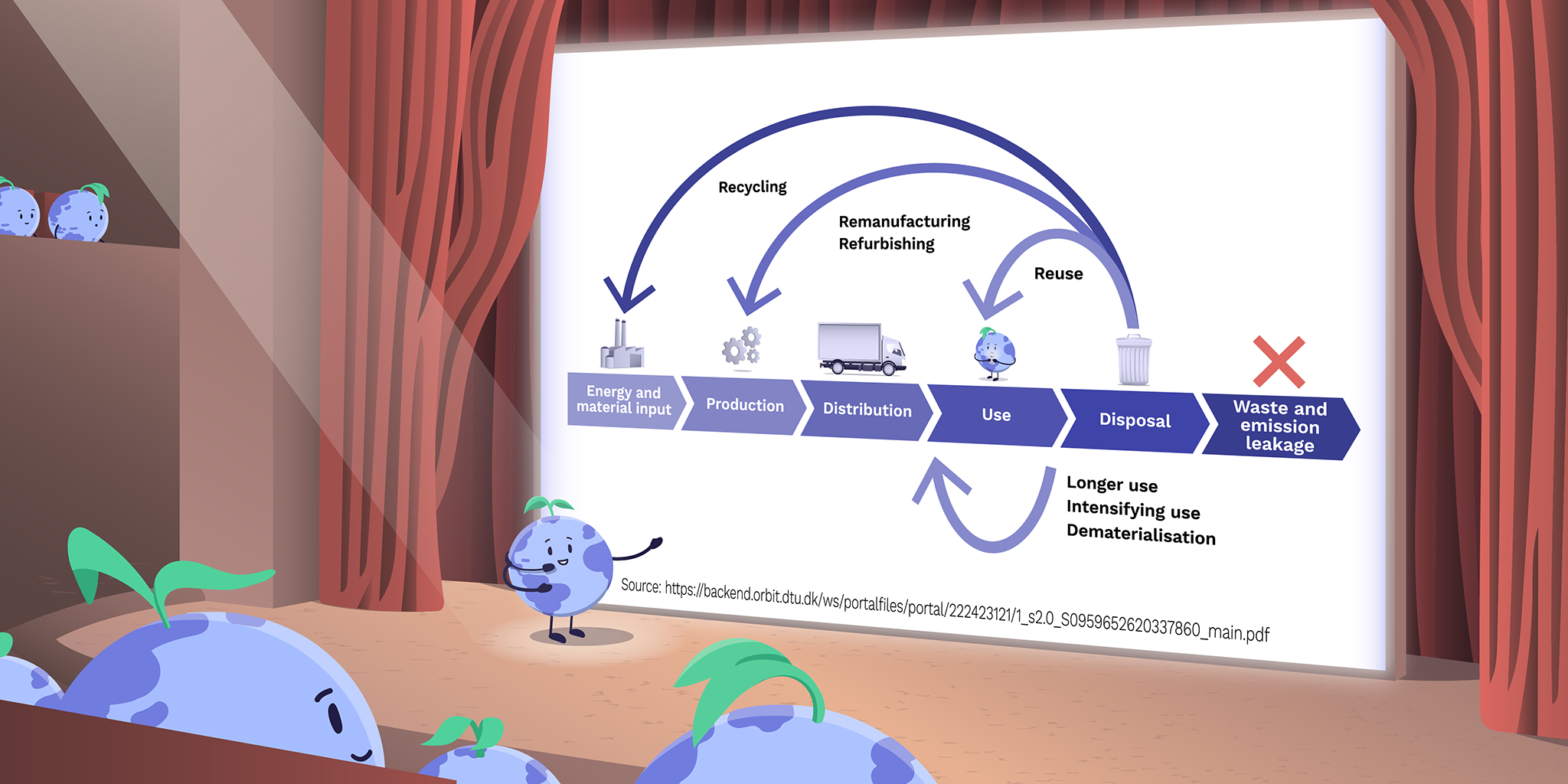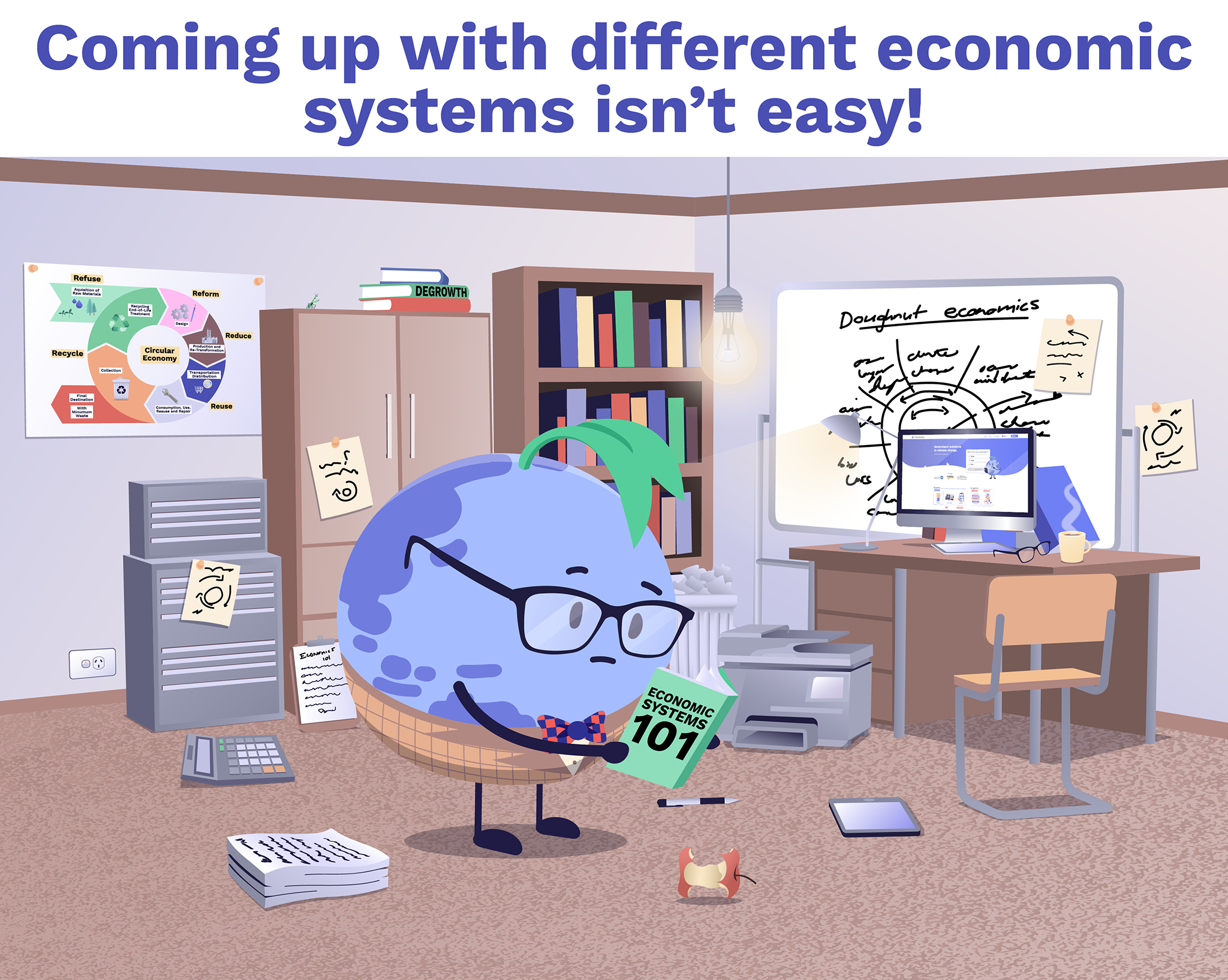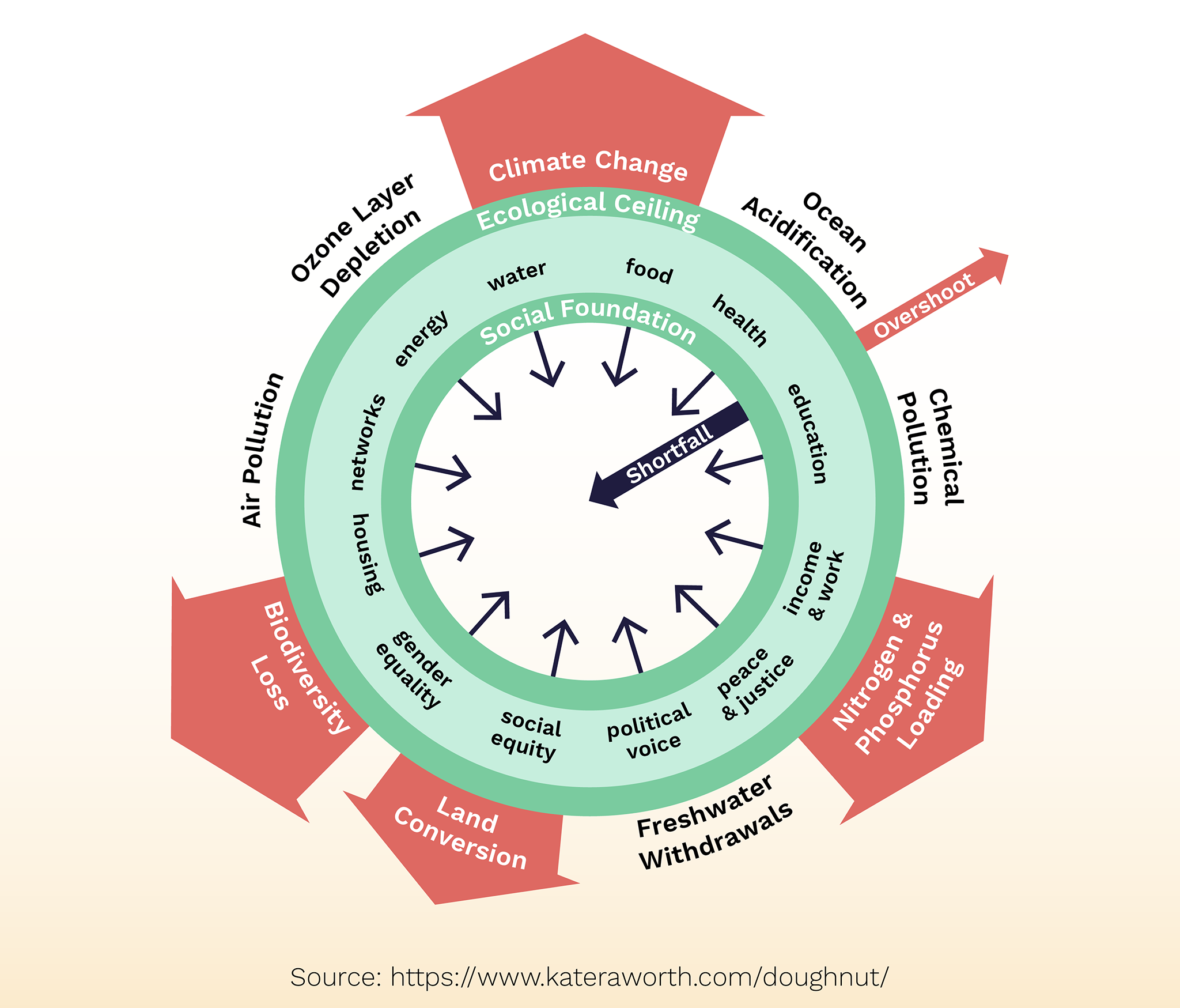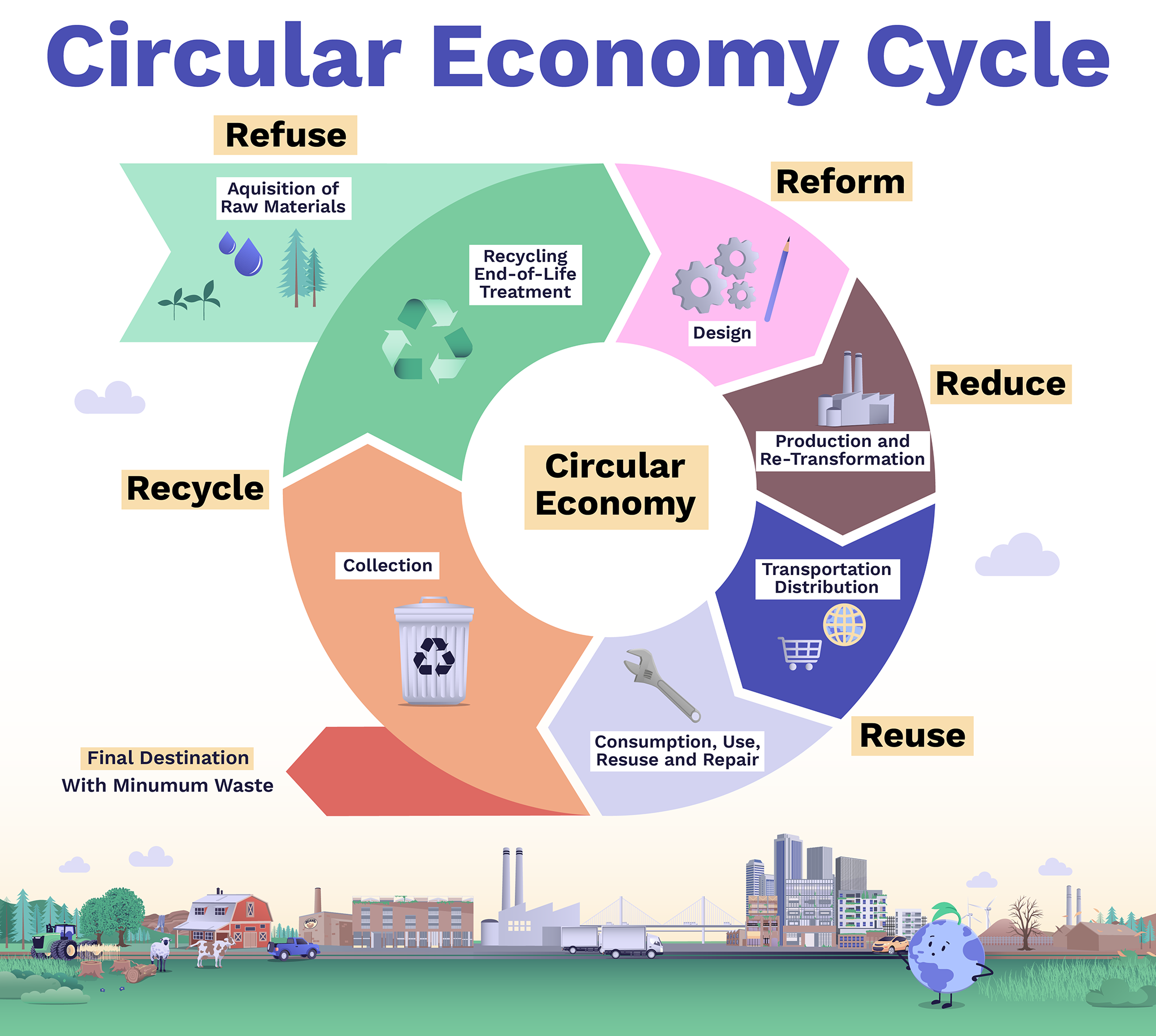Circular Economy: Does a Perfect System Exist?
11 minute read
Updated on: 29 May 2021

Can we stop climate change within our current economic system? While some people think so, others don’t think it’s possible - that the whole system needs to change . In this chapter, we’ll look at some of the ideas about how we could make a change…
The ‘economy’ is itself an invention - something humans have made up . It’s actually changed a lot since it started
! This means that capitalism with always increasing growth doesn’t have to be the main economic system
. A different system might make it easier to stop climate change and other types of environmental damage
. But finding good alternatives is tricky!

Changing Our Economic Thought
So, if we try to imagine a perfect economy, what would we want it to do?
Balancing environmental and human needs
In a nutshell, humanity’s biggest challenge is to meet everyone’s needs without destroying the planet . This means that no one falls short on the things we need to live a healthy and fulfilling life (housing, healthcare, food, water, etc.), whilst making sure that we don’t cause too much damage to our planet’s life-supporting systems (ozone layer, a stable climate, fertile soils, etc.)
.
The doughnut economy can act as a compass for human progress this century.

The doughnut of social and planetary boundaries
The ecological ceiling describes nine environmental factors that, if pushed too far, could lead to catastrophic damage and make it difficult for humans to survive on the planet. You can see that we’re currently overshooting four of those factors
.
The social foundation describes twelve minimum social standards which are necessary for people to have a good quality of life. We’re currently falling short on all of them
…
The space between the social foundation and ecological ceiling is both safe for the environment and fair for human society.
However, looking at the growth of GDP alone won’t tell us if we’re in this space of the doughnut .
Decoupling: “Green growth”
One of the biggest problems with economic growth is that it’s associated with CO₂ emissions - the two are coupled, and more growth means more emissions . Decoupling, or “green growth”, attempts to unlink the two, so growth can occur without producing more emissions
.

Decoupling tries to limit emissions and continue growth
The idea is that a shift to a service economy (rather than one which depends on products, like we have today) will mean emissions are reduced even as growth continues. Improvements in efficiency would also mean that fewer resources and emissions are needed to produce the same amount of stuff.
However, this does not necessarily mean that there will be fewer emissions and resources used overall . This is because the increased efficiency also makes the product cheaper, encouraging more to be used in total
.
One example might be having more efficient car fuels, so the cars travel further with the same amount of fuel. This should mean fewer emissions from cars, but could result in people driving more because it’s cheaper - and emissions increasing overall !
Lastly, some argue that the levels of innovation (increased efficiency) that would be needed to completely decouple economic growth from ecological destruction are too high and unrealistic.
The jury is still out on whether decoupling can truly work, and it would have to happen very quickly to prevent 1.5°C degrees warming.
So, let’s now delve into a topic that may be more feasible and could definitely help in reducing our emissions and waste.
Circular economy: Less is more
The current linear model of the economy, extract-produce-use-dump, is unsustainable. Therefore, some propose a shift from linearity to circularity where there is very little waste. Instead, products are designed to last a long time and can be reused, repaired and refurbished
.

The circular economy
Companies would no longer concentrate on maximising profits through greater efficiency in their operations, but on rethinking products and services so that they last longer and remain within the economy for a long time .
A circular economy can help us reduce emissions and save money at the same time, through increased use of waste materials, higher efficiency and increased sharing of resources . For example, clothing companies can give discount vouchers to their customers when they mail in their old clothes, which are later recycled and turned into new ones
.
It’s estimated that the global economy could benefit by one trillion dollars every year if a circular economy was used worldwide.
This approach could definitely reduce a lot of emissions and save resources along the way. However, it is still dependent on growing our economy. But what if we adopted a system that doesn’t depend on growth at all…
Degrowth: simply different

Degrowth
Different people have different definitions of degrowth. However, it is generally about moving away from a focus on economic growth, and towards a just, sustainable society.
It involves the whole economy getting smaller or staying the same size, which would also reduce and stabilize its impact on the environment (also reducing emissions) .
It is NOT the same as negative growth or an economic recession!
Instead, production and consumption decrease, so the environment and human well-being are enhanced .
There are various principles that encompass most of what degrowth aims to achieve
:
As you can see, degrowth stands for a lot of things and the principles even differ from author to author. It advocates for resources and information to be shared so that everything is accessible to everyone
. It encourages people to spend less time working and more time on leisure, whether that be dancing with friends, having meals with family, or exploring nature
.
Alongside that, it promotes what economists call unproductive expenditure. This is spending money without seeking to gain a profit, through projects such as carnivals, community centers and expansion of arts and culture
.
Most importantly, degrowth requires a slowing down of consumption and production as well as reducing how much waste we create, and allowing it to all circle back into the economy to be used again and again and again (like in our circular economy example!) .
In summary, the aim of the degrowth movement is to enable humanity to be happier and to live in harmony with nature.
We know what you’re thinking: if this system is so perfect then why haven’t we adopted it already?
Well, the main problem is that, by definition, degrowth comes at the cost of personal income losses for the residents of the country undertaking the policy (as people would work less, spend less, etc.) . This would, unfortunately, never be a popular policy so politicians are unlikely to start it. But if more people are educated about it and are willing to vote for politicians who support these policies then maybe, just maybe they’ll start implementing them.
Lastly, and most importantly, supporters of degrowth recognize that low- and middle-income countries have been left at a disadvantage by the effects of colonialism, and support the growth of their economies in the near future (still with respect to the social and planetary boundaries).
Conclusion
It’s clear that our economy needs to change. It’s also clear that there are many individuals actively thinking about how to bring about this change in a just and fair way for everybody.
Whatever the case may be, these ideas are all interesting examples of what a different future could look like because a different future is necessary.
If you were to remember one thing from this course it is that our planet has boundaries and we are crossing them at an unbelievable pace. We need to correct these faults, which requires drastic action. Acknowledging these boundaries may just be enough to unleash the creative potential needed to meet the challenges ahead.

